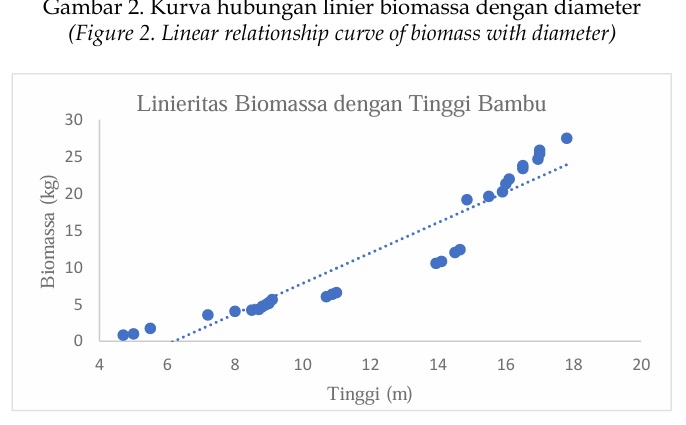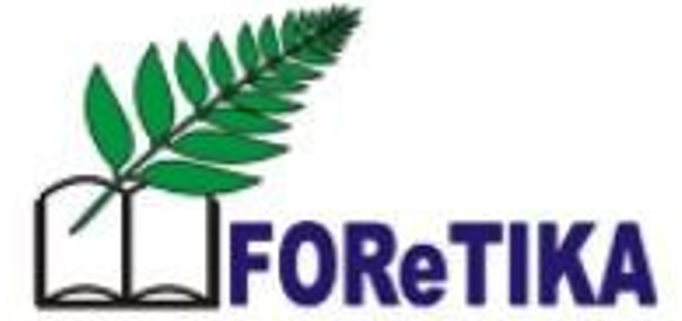Model Alometrik Penduga Aboveground Biomass Gigantochloa atter di Desa Alu, Kabupaten Polewali Mandar.
Allometric Model to Estimate Aboveground Biomass of Gigantochloa atter in Alu Village, Polewali Mandar Regency.
DOI:
https://doi.org/10.22219/avicennia.v7i1.32057Keywords:
Allometric, Biomass, Gigantochloa, atter, PolmanAbstract
Biomass allometric models are needed to determine the carcon content absorbed by bamboo plants. There are still many bamboo plants that do not have a local allometric model to estimate their biomass, one of which is Gigantochloa atter bamboo. This research aims to produce an allometric model for estimating the biomass of Gigantochloa atter bamboo found in Alu Village, Polewali Mandar Regency, West Sulawesi Province. Dustructive sampling method of 30 bamboo plants, to obtain wet weight and water content, starting with measuring the diameter and total height. Water content to determine biomass. Biomass, diameter and height values were analyzed by regression to develop allometric models according to predetermined equations. Substitution of measurement values into the allometric equation and data analysis using the coefficient of determination (R2), bias, error index and Mean Square Error Prediction variable scoring method. The scoring results of six models for estimating the biomass of Gigantochloa atter bamboo plants in Alu Village, Polewali Mandar Regency were selected as the best model Y = 0.785+0.011(D2H) with the highest score values including R2 value (0.982), Bias value (0.124), IE value (25.086 ) and MSEP (1.435).
Downloads
References
[BSN] Badan Standarisasi Nasional. 2002. SNI No: 03-6848. Metode Penguji Berat Jenis Batang Kayu dan Kayu Struktur Bangunan. Jakarta.
[BSN] Badan Standarisasi Nasional. 2011. SNI No: 7725. Penyusunan persamaan alometrik untuk penaksiran karbon tersimpan hutan berdasarkan pengukuran lapangan (ground based forest carbon accounting). Jakarta.
Arinah, H., Muhdi, M., & Azhar, I. (2016). Pendugaan cadangan karbon pada tanaman bambu talang (Schizostachyum brachycladum kurz.) di hutan rakyat bambu desa pertumbukan Kecamatan Wampu Kabupaten Langkat. Peronema Forestry Science Journal, 5(2), 34-48.
Daud, M., Hikmah, & Haerana. (2018). Potensi produksi oksigen pada tegakan bambu parring (Gigantochloa atter) di hutan rakyat Kecamatan Tompobulu Kabupaten Maros. Jurnal Matoa, 6(12), 27-39.
Hartoyo, A. P. P., Khairunnisa, S., Pamoengkas, P., Solikhin, A., Supriyanto, S., Siregar, I. Z., & Istomo, I. (2022). Estimating carbon stocks of three traditional agroforestry systems and their relationships with tree diversity and stand density. Biodiversitas Journal of Biological Diversity, 23(12).
Haygreen JG dan Bowyer JL. 1996. Hasil Hutan dan Ilmu Kayu. Edisi ke-4. Yogyakarta: University Gadjah Mada Press.
Ministry of Environment and Forestry [MoEF]. 2022. Rencana Operasional Indonesia’s FOLU Net Sink 2030. Kementerian Lingkungan Hidup dan Kehutanan, Jakarta.
Pertiwi, Y. A. B., Nufus, M., Agustina, A., Rahmadwiati, R., Wicaksono, R. L., & Nayasilana, I. N. (2021). Keanekaragaman, biomassa dan cadangan karbon bambu di taman hutan raya KGPAA mangkunagoro I. Jurnal Belantara 4(2), 140-152.
Prawira, M. R., Hadijah, S., Nuraeni, M., & Ritabulan, R. (2021). Pemetaan Isu dan Willingness to Pay (WTP) di Hutan Bambu Alu dari Sudut Pandang Pengunjung dan Calon Pengunjung. Gorontalo Journal of Forestry Research, 4(2), 113-125.
Ritabulan, R., Tasmin, T., Irundu, D., Qaizar, K., & Arham, I. (2023). Development Strategy based on Potential Ecotourism Feasilibity in Hutan Bambu Alu, West Sulawesi. Jurnal Penelitian Kehutanan BONITA, 5(1), 9-16.
Ruslianto, Mila, A., Maisuri, & Daud, I. (2019). Allometric Models of Rhizophora apiculata Biomass in Polewali Mandar District, West Sulawesi Province. Buletin Eboni, 1(1), 11-19.
Selanno, F. M., Mardiatmoko, G., & Boreel, A. (2017). Studi Pendugaan Allometrik Tingkat Permudaan Di Hutan Lindung Gunung Sirimau, Kota Ambon. Jurnal Hutan Pulau-Pulau Kecil, 1(4), 287-297.
Singnar, P., Das, M. C., Sileshi, G. W., Brahma, B., Nath, A. J., & Das, A. K. (2017). Allometric scaling, biomass accumulation and carbon stocks in different aged stands of thin-walled bamboos Schizostachyum dullooa, Pseudostachyum polymorphum and Melocanna baccifera. Forest Ecology and Management, 395, 81-91.
Situmorang, Y., Muhdi, M., dan Azhar, I. 2016. Model alometrik biomassa dan massa karbon bambu belangke (gigantochloah pruriens widjaja.) Di hutan rakyat desa sirpang sigodang, kecamatan panei, kabupaten simalungun. Peronema Forestry Science Journal, 5(2), 210-223.
Sutaryo, D. (2009). Penghitungan Biomassa Sebuah pengantar untuk studi karbon dan perdagangan karbon. Wetlands International Indonesia Programme. Bogor, 13.
Tato'Appi, W., Mananohas, M. L., & Langi, Y. A. (2019). Penentuan Model Persamaan Regresi Alometrik Terbaik Untuk Menduga Biomassa Pohon Cempaka (Elmerrillia ovalis) Di Kecamatan Tareran Kabupaten Minahasa Selatan. d'CARTESIAN: Jurnal Matematika dan Aplikasi, 8(1), 69-75.
Yusandi, S., & Jaya, I. N. S. (2016). The estimation model of mangrove forest biomass using a medium resolution satellite imagery in the concession area of forest concession company in West Kalimantan. International Journal of Bonorowo Wetlands, 6(2), 69-81.

Downloads
Published
Issue
Section
License
Copyright (c) 2024 Daud Irundu, rahmania RM, Wahyudi, Ritabulan, Mila alviani

This work is licensed under a Creative Commons Attribution 4.0 International License.
Authors who publish with this journal agree to the following terms:
- Authors retain copyright and grant the journal right of first publication with the work simultaneously licensed under a Creative Commons Attribution License that allows others to share the work with an acknowledgement of the work's authorship and initial publication in this journal.
- Authors are able to enter into separate, additional contractual arrangements for the non-exclusive distribution of the journal's published version of the work (e.g., post it to an institutional repository or publish it in a book), with an acknowledgement of its initial publication in this journal.
- Authors are permitted and encouraged to post their work online (e.g., in institutional repositories or on their website) prior to and during the submission process, as it can lead to productive exchanges, as well as earlier and greater citation of published work (See The Effect of Open Access).










